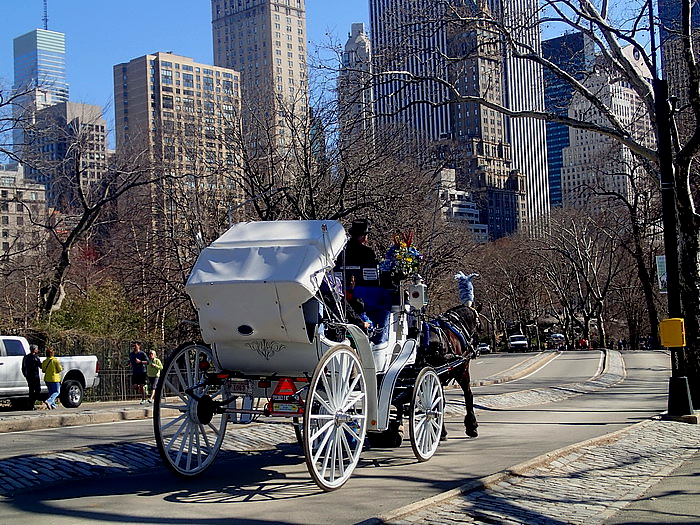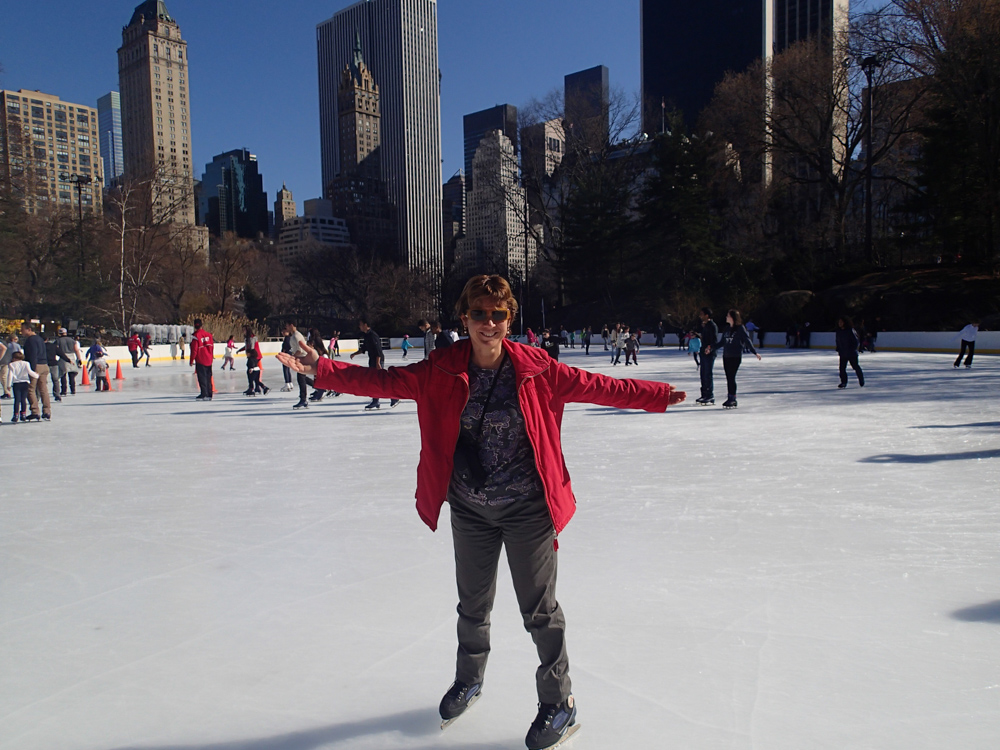CENTRAL PARK
(between Central Park West/5th Avenue and 59th/110th Street)
New York’s beloved Central Park lived through a lot. To mention a few: concerts of Pavarotti, Patti Smith or Simon and Garfunkel, was a location of numerous movie shoots, demonstrations, parades, theatre performances – and several murders.
In summer you have to lie down on the grass, enjoy the sunshine and the unbelievable mix of people. The whole city is here on the weekends: riding bikes, jogging, roller skating, walking with the grandkids. The half-naked roller skating guy happily flies by the lady walking with a lapdog in her arms, the thin, bespectacled, accountant-looking gentleman is sheepishly trying out his new skate board. Saturdays and Sundays (between 2:30 and 8:30 pm) it’s worth checking out the dancing roller skaters in the park near 72nd Street – there is a great atmosphere there.
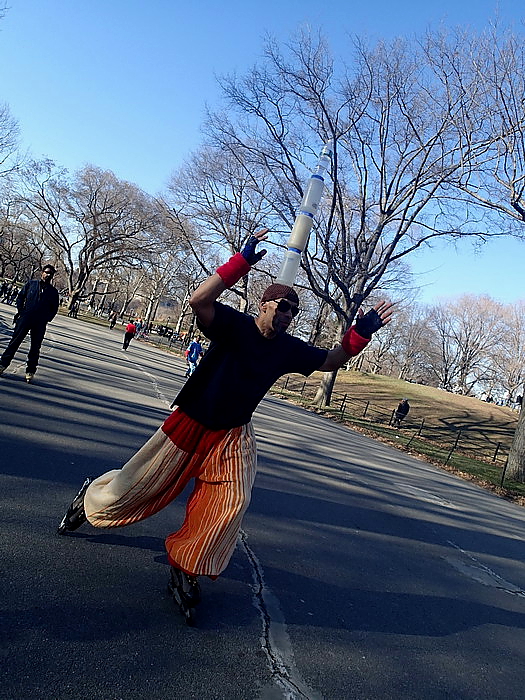

Do not miss out on the park in winter either. One of my most memorable New York evening was when a few days before Christmas I was skating around admiring the lit up skyscrapers while John Lennon songs were playing.
The idea of the park came from William Cullen Bryant, a poet-journalist. Its two designers, Frederick Olmsted and Calvert Vaux opened the park in 1876 and it immediately made them the most sought out park designers of America. They designed for example, the Riverside and Morningside parks in Manhattan and Prospect Park in Brooklyn. They didn’t have an easy job: it took 16 years to build this idyllic world from the stinky swamp and rocky barren soil.
We can circle the park on foot but it’s more exiting on roller skates. If you didn’t bring any, no problem, you can rent them at Blades on 72nd Street between Columbus and Amsterdam Avenue. The park is car-free on weekends and also on weekdays outside of rush hour, so you can roller skate anywhere. It took me an hour and half to go around it (without sightseeing, solely for exercise) but then after practice it went down to an hour. Knee and elbow pads are a must, no matter how silly you look with them. After the first fall, you’ll discover why. I really wouldn’t have wanted to see the same scratches on my skin that ended up on my knee pads.
Let’s start the walk, let’s say, from the Central Park Zoo near the corner of 65th Street and 5th Avenue which cannot compete with its big brother in the Bronx but it’s not bad. Walking towards the inside of the park, the first stop is the Chess and Checkers House where there are 24 outdoor and 14 covered chess boards for those who wish to play. A bit south from this is the Wollman Rink where an excellent skating rink operates in winter (there is rental so no excuses).
There is a little surprise for those who like fun fairs: the Friedsam Memorial Carousel with its horses and old fashioned music.

North of this is the Sheep Meadow where hundreds of young people hang out on the grass, play frisbee, have a few beers.
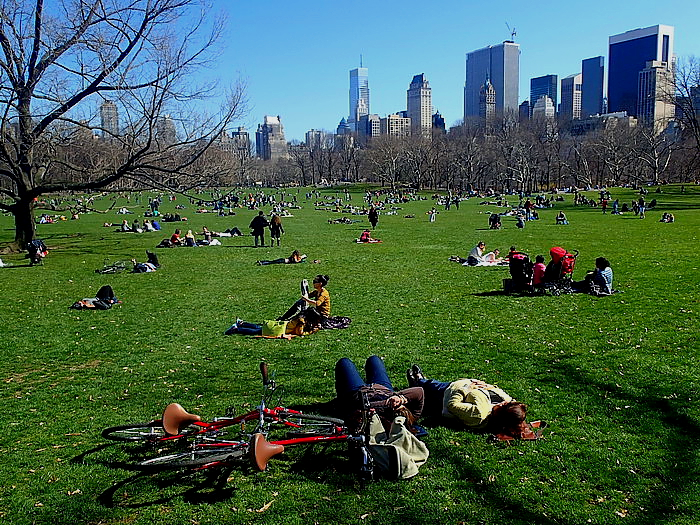
The Mall is west of Sheep Meadow and is a shady path with large trees and lion sculptures. The Rumsey Playground, the locations of the Summerstage plays, is at its northern end. The performances are free but it’s better to arrive early for popular concerts if you want to get in. It’s not a tragedy though even if you don’t get in because you can always sit down outside the fence as everything can be heard perfectly.
North of 72nd Street we can find small and large lakes with various flowers, birds and boating opportunities. At the boathouse next to the big lake you can rent boats, gondolas and other water vehicles and also bicycles. You’ll need some kind of ID to leave in exchange.
The Conservatory Water is the location of boat model races every Saturday from March till September. Salinger fans can find it familiar from the Catcher in the Rye, this is where the main character comes to share his sorrows with the ducks.
The nearby Alice in Wonderland statue is a favourite of the little ones. This is a group of sculptures on which it’s allowed to climb (and climb they do). Next to it is the statue of Hans Christian Andersen where in summer sometimes there are story time mornings sponsored by the New York Public Library.
The obelisk behind the Metropolitan Museum was a gift from Egypt.
On the other, western, side of the park, near the Dakota Building, is a small square called Strawberry Fields which was created by Yoko Ono in memory of her murdered husband in 1985 (when Lennon would have turned 45).The plants were bought here from 123 countries and loads of presents were given by other places, too – for example, the “Imagine” mosaic by the walking path came from Naples. Every year hundreds gather here on John Lennon’s birthday (Oct. 9.) and on the anniversary of his death (Dec. 8.). I also came once on December 8 to remember Lennon with a small flower. In the bitter cold we sang Beatles songs for hours with candles and flowers while tapping our feet in the freezing weather and drinking hot tea. Strangers were handing a guitar around and everyone knew all the songs by heart – it was a very moving evening.
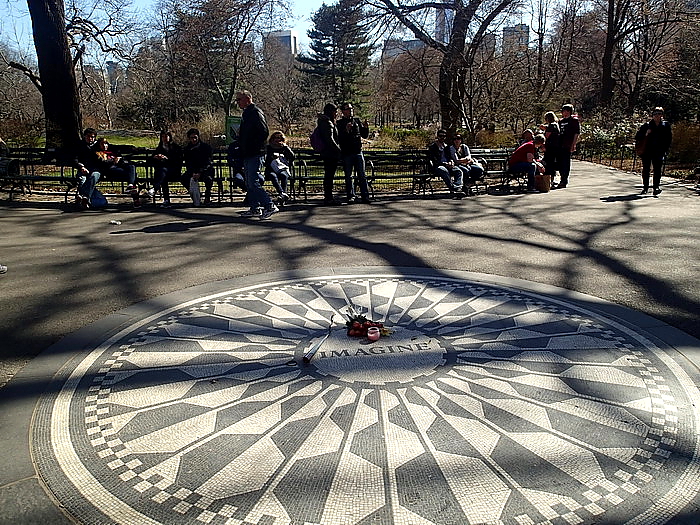
North of the big lake is the Ramble, the most wooded part of the park, where there are organized tours for bird watchers since 250 types of birds live here. Lonely walkers should avoid this area it could be quite frightening. The Belvedere Castle is at the level of 79th Street and there is a great view of the park from it. It used to be a meteorological station now it’s the headquarters of the green uniformed park keepers.
Among the seven original cast iron bridges of the park, maybe Bow Bridge is the prettiest and it provides a lovely view to the park. It might be the most romantic spot in the city, no wonder it appeared in lots of movies and advertisements (Manhattan, The way we were, Keeping the faith). Other areas of the park also should be familiar from numerous movies, like the two classic romances: When Harry met Sally or the Serendipity.

There is a database about movie scenes played in the park – or anywhere else in the city.
The Delacorte Theater is the location of the very popular Shakespeare in the Park. The performances are free but it’s almost impossible to get tickets.
The Great Lawn is north of the theatre and popular concerts are held here. Every summer, amongst others, the New York Philharmonic and the Metropolitan Opera perform and even the pope gave a speech on this large lawn. In the northern area of the park is the largest lake of the city, the Reservoir, a favourite of the joggers. There is a constant stream of healthy living fans on the path around it trying to lose the hamburger and soda calories.
On the subject of running: Central Park is the end point of the annual New York City Marathon. First I came to see it only because movement was the topic in my photography class and though it would be a good occasion to take sport pictures. Immediately the atmosphere of the race grabbed me and with 2.5 million others I stayed for hours to cheer on the 25 thousand runners. It has a fantastic atmosphere. Policemen were jogging next to the tired, disheartened competitors using loudspeakers to tell some jokes to cheer them on. Thousands and thousands supported each runner: Don’t give up, you can do it! And there were moving moments, too. There were lots of participants in wheelchairs or other disabilities and even blind people supported by their sighted friends.
One of the runners twisted his ankle a few hundred metres before the end. Another saw this, stopped and picked him on his shoulders and carried him over the finish line. This made him slip down the rankings but didn’t want the other to give up so close to the end. If you’re in the city in November, definitely should go and watch it – it’s memory for a lifetime.
